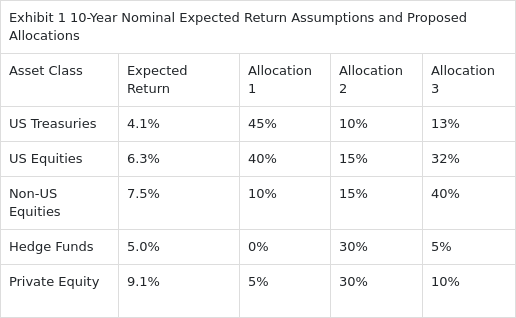NO.PZ2019100901000007
问题如下:
Azarov’s second meeting is with John Spintop, chief investment officer of the Wolf University Endowment Fund (the Fund). Spintop hired Westcome to assist in developing a new investment policy to present to the Fund’s board of directors. The Fund, which has assets under management of $200 million, has an overall objective of maintaining long-term purchasing power while providing needed financial support to Wolf University. During the meeting, Spintop states that the Fund has an annual spending policy of paying out 4% of the Fund’s three-year rolling asset value to Wolf University, and the Fund’s risk tolerance should consider the following three liability characteristics:
The Fund has a small investment staff with limited experience in managing alternative assets and currently uses the Norway model for its investment approach. Azarov suggests a change in investment approach by making an allocation to externally managed alternative assets—namely, hedge funds and private equity. Ten-year nominal expected return assumptions for various asset classes, as well as three proposed allocations that include some allocation to alternative assets, are presented in Exhibit 1.
Expected inflation for the next 10 years is 2.5% annually.

Which proposed allocation in Exhibit 1 would be most appropriate for the Fund given its characteristics?
选项:
A.
Allocation 1
B.
Allocation 2
C.
Allocation 3
解释:
C is correct.
Allocation 3 is the most appropriate allocation for the Fund. The annual expected returns for the three allocations are as follows:
Allocation 1 exp. return = (0.45 × 4.1%) + (0.40 × 6.3%) + (0.10 × 7.5%) + (0.05 × 9.1%)= 5.57%.
Allocation 2 exp. return = (0.10 × 4.1%) + (0.15 × 6.3%) + (0.15 × 7.5%) + (0.30 × 5.0%) + (0.30 × 9.1%)= 6.71%.
Allocation 3 exp. return = (0.13 × 4.1%) + (0.32 × 6.3%) + (0.40 × 7.5%) + (0.05 × 5.0%) + (0.10 × 9.1%)= 6.71%.
The real return for Allocation 1 is 3.07% (= 5.57% – 2.50%), and the real return for Allocation 2 and Allocation 3 is 4.21% (= 6.71% – 2.50%).
Therefore, Allocation 1 is not appropriate because the expected real rate of return is less than the annual spending rate of 4%. With expected spending at 4%, the purchasing power of the Fund would be expected to decline over time with Allocation 1.
Allocations 2 and 3 both offer an expected real rate of return greater than the annual spending rate of 4%. Thus, the purchasing power of the Fund would be expected to grow over time with either allocation. However, Allocation 3 is more appropriate than Allocation 2 because of its lower allocation to alternative assets (hedge funds and private equity). The total 60% allocation to alternative assets in Allocation 2 is well above the 15% allocation in Allocation 3 and is likely too high considering the Fund’s small investment staff and its limited experience with managing alternative investments. Also, given the Fund’s relatively small size of assets under management ($200 million), access to top hedge funds and private equity managers is likely to be limited.
请问考试时需要列出计算过程吗?还是直接写每种资产的return



